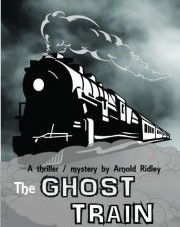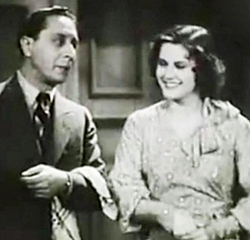
A Joker pulls the emergency cord to stop the train in order to retrieve his hat that had flown out a window. This causes the train to arrive at the station late, and with no other trains coming until morning, stranding a group of passengers. Besides the Joker, the group include a newly Married Couple, a Cute Girl traveling with an Earnest Man, a teetotaling, Prissy Lady with a parrot, and a Doctor. They are warned by the Station Master that the station is haunted and that a ghost train comes by at night, and if they want to survive, they need to leave. They refuse, and the Station Master abandons them in fear of the ghosts. What follows is a string of spooky events, including a death and then the disappearance of the corpse, strange sounds and lights, the arrival of a crazed woman, and the passage of the ghost train itself.

The Ghost Train was a very popular British play. Written by Arnold Ridley in 1923, it had a successful run and has seen numerous revivals. It was adapted for the screen in 1927 in a British-German coproduction, and like so many other Dark House movies, it was remade once sound was in place just a few years later, in 1931, this time just by the British. Next, in 1933, came two from the European continent, the Romanian Trenul fantomă and Hungarian Kisértetek Vonata. The French Un Train Dans La Nuit was released in 1934, but that one will get no more discussion here as no prints are known to survive. In 1939 the Dutch joined in with De Spooktrein. And finally the Brits took it back in 1941. There have been four more official versions since then, and a number more that “borrowed” from it, but I’ll stick with the years from ’31 to ‘41.
It’s surprising how much alike the five surviving films are. The basic plot is exactly the same, with all the same major events occurring in the same order, and with few changes to even the minor ones. While the character names change (I’ll use descriptive names for each), their personalities shift only a bit. Footage is even shared between three of them, and the 1941 version had the same director as the 1931, so perhaps it isn’t that surprising.
The Ghost Train is an Old Dark House story transplanted to a railway station. The characters are properly quirky, there’s a dead body and strange lights and talk of ghosts, plenty of comic relief, and an eerie atmosphere. The story line is entertaining enough, and certainly has been popular. The characters are not complex or deeply developed, but rather were intended to represent a cross section of British society in the 1920s, thus supplying a bit of commentary while also being easy to identify. Everything is here for a thoroughly entertaining film. However, a few flaws are inherent to the structure that have been magnified in different productions. The story is good, but it’s brief, at least as executed in all five films (I’ve never seen the play and am curious how it fills nearly two hours). There’s approximately an hour’s worth of material. When an adaptation gets much over that, it drags. As the story was written for the stage, there’s a tendency to replicate that a bit too closely. I’m not a fan of opening up a film for no purpose when made into a movie, but most of these renditions could be converted back into a stage play without making any changes. A few more locations or some clever manipulation of the camera to better tell the tale would be nice. But inventive cinematography is not in abundance. Also, the Joker is supposed to be annoying to the other passengers, but he can easily become annoying to the audience. And if the film features him as the lead instead of part of the ensemble, as several do, he can become downright unpleasant.
How do the individual adaptations fare?
Trenul fantomă and Kisértetek Vonata can be reviewed together. Just as Hollywood used to film the same feature in multiple languages for release in different countries (for example, Dracula and Drácula from 1931), these were shot together, one for Romania and one for Hungry. They use the same sets, have the same style and pacing, and both use the same exterior shots, taken from the 1931 British version. However, they had different cast and crew, and of course, different languages. Both are short, one at 64 minutes and the other at 71. I can’t find reliable information on the original lengths of either film, but neither seem to be cut. The major difference between them is that while both add a song performed by the Joker and Cute Girl to entertain the others, Trenul fantomă adds another early in film that feels out of place and stops the film dead. Outside of that, these are well paced compared to the ’31 version. They also tone down the Joker, making him only a little irritating. Since he and the Cute Girl are clearly the stars, the others get short shrift. This is partly mitigated for The Couple, who are made more affectionate, thus giving them something to do, which is kissing and fawning over each other.
 These are low budget films—not surprising with the reuse of footage—and it shows with static shots, uninspiring sets, and drab lighting. There’s little movement even in the main room, and people rarely leave it. But superior pacing beats out the lack of funds, making these enjoyable renditions. And there’s little to choose between them. Without seeing them side by side I wouldn’t be able to tell the lead actors apart. I give Kisértetek Vonata the edge, partly for the lack of the early song, but more for Marika Rökk as the Cute Girl, in these versions named Mary. A star of German musicals, she’s electric: sexy, intense, and funny. She’s the only actress in all five films who stands out in the part.
These are low budget films—not surprising with the reuse of footage—and it shows with static shots, uninspiring sets, and drab lighting. There’s little movement even in the main room, and people rarely leave it. But superior pacing beats out the lack of funds, making these enjoyable renditions. And there’s little to choose between them. Without seeing them side by side I wouldn’t be able to tell the lead actors apart. I give Kisértetek Vonata the edge, partly for the lack of the early song, but more for Marika Rökk as the Cute Girl, in these versions named Mary. A star of German musicals, she’s electric: sexy, intense, and funny. She’s the only actress in all five films who stands out in the part.